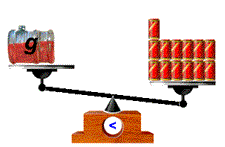![[the epicenter]](../../../../banner.gif)
![[the epicenter]](../../../../banner.gif)
![[educational software - mathematics education]](../../../subjects/math/math0.gif)
![]()

Age Range: 10-Adult
Platform: Windows
Medium: CDROM
Cost: Multi-User Stand-Alone $195
5 CD Lab Pack $595
10 CD Lab Pack $995
50-User Network $1,595
Unlimited Network $1,995
(Consumer Versions Available for $49.98)
Company: Boxer Learning, Inc.
Phone: (804) 817-5900
Fax: (804) 817-5910
Description:
Boxer Introductory Algebra 2.0 bridges the gap between arithmetic and algebra. This self-paced, interactive math tutorial includes over 90 activities covering nine topic areas starting with integers and going through to linear equations. Interactive questions engage and involve learners while the visual simulations and innovative graphics aid comprehension. On-screen manipulations and well-written problems put concepts in real world scenarios that students can relate to and understand. The comprehensive management system allows record keeping, topic assignment, and accurate assessment of your students' needs and progress.
Features
Boxer Introductory Algebra 2.0 Scope and Sequence
Introduction
Getting Started * Our Teaching Methods * How to Use our Program
Integers
Whole Numbers Defined * Place Value * Sets * Number Lines * Visually Comparing Whole Numbers * Inequality Symbols and Expressions * Reading Equations and Inequalities * Rounding Whole Numbers with and without Number Lines * Numerical Expressions * Evaluating by Following the Order of Operations * Grouping Symbols in the Order of Operations * Associative, Commutative and Distributive Properties * Counter-examples for Subtraction and Division * Picturing Addition, Subtraction, Multiplication, and Division on a Number Line * The Inverse Relationship Between Addition and Subtraction, Multiplication and Division * Negative Numbers Defined with Examples * Negative Numbers on a Number Line * Absolute Value on a Number Line * The Formal Rule for Finding Absolute Values * Adding, Subtracting, Multiplying and Dividing Integers using a Number Line and Formal Strategies * Understanding the Effect of Negative Signs in Arithmetic
The Language of Algebra
Introduces the Idea of a Variable * Real-world Examples of Variables * How Variables are Used * Finding and Naming Variables in Real-World Problems * Units and Reasonable Values * Estimation * Graphs, Tables and Equations for Presenting Information * Solving Problems with Tables and Graphs * Variable Expressions * Phrases used to Represent Mathematical Operations * Simplifying and Evaluating Variable Expressions * Mathematical Sentences: Equations and Inequalities * Representing Equations and Inequalities with a Scale * Expressing Problems as Mathematical Sentences * Expressing Inequalities and Operations in English * Solving Mathematical Sentences * The Guess and Check Method * Showing Solution Sets of an Inequality on a Number Line * Guidelines for Problem Solving
Solving with Addition and Subtraction
The Gasoline Problem: Visualizing and Solving on the Scale * The Mountain Problem * Solving x + a = b * Identifying Operations and Doing Reverse Operations to Both Sides * Solving Equations with a Number Line * Solving Inequalities * Rearranging Inequalities into Standard Form * Density * The King's Crown Problem: Solving a Famous Historical Problem
Fractions and Decimals
Fraction Fundamentals * Numerator and Denominator * Adding Fractions with Like and Unlike Denominators * Multiplying Fractions * Equivalent Fractions * Comparing Fractions with Like and Unlike Denominators * Reducing Fractions by Dividing Out Common Terms * Greatest Common Factor * Prime Numbers * Prime Factorization * Mixed Numbers * Improper Fractions * Adding Fractions and Mixed Numbers with Like and Unlike Denominators * Dividing Factions * Reciprocals * Adding and Subtracting Fractions Having the Least Common Denominator * Least Common Multiple * Decimals and Percents * Converting Fractions, Decimals and Percents * The Set of Rational Numbers * Irrational Numbers * The Irrational Number p and Circumference
Solving with Multiplication and Division
Solving ax = b * Doing Reverse Operations to Both Sides * Rate x Time = Distance * The Sailing Problem * Solving x/a = b * Solving with a Number Line * Solving Inequalities with Multiplication and Division * Emphasizes When the Inequality Must be Switched
Exponents
Defines Exponent, Base and Exponential Expression with Examples * Exponential Growth * Exponents in the Order of Operations * Multiplication Law of Exponents * Power Rule * Quotient Rule * Zero Exponent Law * Uses of Scientific Notation * Translating into Scientific Notation * Exponents in Geometry * Area, Volume and Square Units * The Garden Problem * Square Roots * * as an Exponent * Perfect Squares * Radical Notation * Radical Properties Related to Properties of Exponents
Solving with Roots and Powers
Solving |x| = bng x2 = b * The Role of Absolute Values in Solving x2 = b * Solving Ö x = b * Inequalities and |x|* Showing Solution Sets on a Number Line * Inequalities and x2 * Inequalities and Ö x * Excluding Negative Values from the Solution Set * The Pythagorean Theorem Defined with Examples * Right Triangles
Multi-Step Equations
Solving ax + b = c * Identifying Multiple Operations and the Reverse Operations * Simplifying Expressions * Collecting Like Terms * Using the Distributive Property with Variables * Solving Equations with Variables on Both Sides * Equations that have no Solutions * The Profit Problem
Linear Equations
Representing Data with Bar Graphs * The Cartesian Coordinate System * Defines Axes, Origin, Quadrant, and xy-plane * Ordered Pairs * Using Lines as Prediction * The Beehive Problem * Lines in the xy-plane * Introduces the Connection Between Lines and Linear Equations * Slope as Rise/Run and Formal Definition * Slopes of Parallel and Perpendicular Lines * Slope and Equations of Lines * Y-intercept * Slope-Intercept Form of a Linear Equation * Point-Slope Form of a Linear Equation * Connection Between Point Slope Form and the Slope Formula * Linear Inequalities * Graphing the Solution to an Inequality as a Half-plane
For further information, click here
We hope you found what you needed on this page. If you have
any questions or comments, please contact me.
![]()
Howard J. Bender, Ph.D.
President
The Education Process Improvement Center, Inc.
P.O. Box 186
Riverdale, Maryland 20738
hjbender@epicent.com